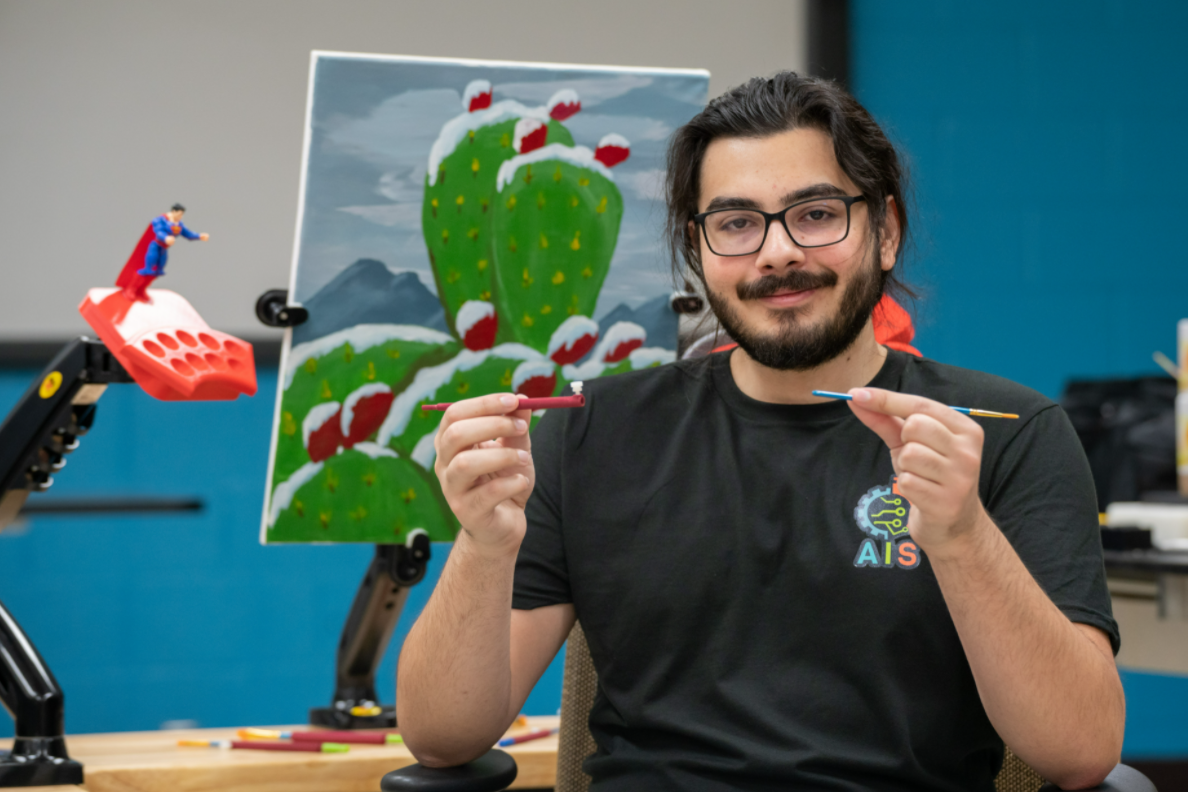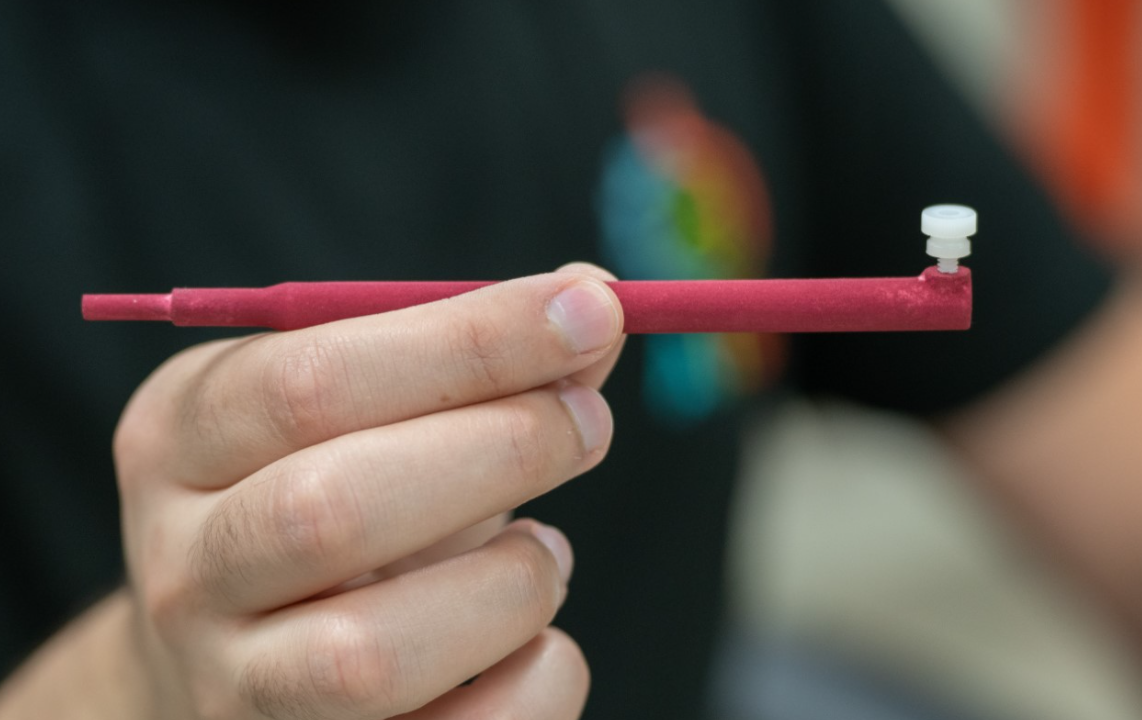Drive, compassion and innovation paint a beautiful picture


Sam Cueto likes to paint, mostly landscapes and abstract paintings. It has been a difficult interest for him to pursue – Cueto is a quadriplegic. His drive, a compassionate therapist’s search for a solution and the technological help of engineering students at New Mexico State University, led to a uniquely designed art station that makes it easier for him to engage in his creative past-time.
Cueto lost his mobility due to negligence during a surgery when he was eight years old.
“Sam had been painting for quite some time. Some of his therapists tried to jimmy a way for him to hold a paintbrush in his mouth with a head array,” said Erika Hernandez, Cueto’s occupational therapist for the past year. Former therapists encouraged Cueto to paint as a method to strengthen his neck and increase head control.
“It was like a head gear that I used to use and it put a lot of stress on my jaw and my neck. We just had a little stand so I had to be repositioned a lot. I had to lean forward and it wasn’t independent as I would have liked to be painting,” said Cueto.
Even so, Cueto had success with his work. His family’s veterinarian has been using his paintings on postcards sent to remind patients of vaccination dates and appointments.
Hernandez set out to find painting adaptations for people with physical limitations but found that there were not many options. She knew that engineering students have to complete a project as requirement of graduation and thought they might be able to tweak an existing device to make it work for Cueto.
“I just thought outside of what I could do and looked at the resources around us that might provide something outside of traditional things. I cast that line and got a bigtime bite and it was phenomenal,” said Hernandez.
The big bite came from Gabe Garcia, associate dean of experiential learning and student success for the College of Engineering. This past spring semester, Garcia gave the idea to a senior engineering capstone class, the culmination of an engineering student’s degree program when students design and manufacture a project.
Hernandez, Sam’s mother, his physical therapist and speech language pathologist provided Garcia with insight for the design to meet Cueto’s needs. He needed a device that would support a brush and help to position the canvas, enable the canvas to be positioned closer to him. The student group and Hernandez met with Sam on Zoom to discuss the project at the beginning of the spring semester.
Sami Naser served as lead engineer for the project, Micheal Rivera, team manager; Amanda Stoyanoff, documentation engineer; Joshua Santana, Andres Caballero and Sam Torres made up the rest of the team. The students designed a free-standing art station, outfitting it with mechanical arms and other parts. They were assisted by fellow students Veronica Gurrola, Kelsey Hayes and Reyes Lucero in the Aggie Innovation Space who created parts using 3-D printing and other methods of fabrication.
We couldn’t have had a better group,” said Naser. “There were no slackers.
“Our first goal was to identify the needs of the client,” said Naser. “It needed to be light and comfortable, have a lighter mouth piece and we wanted it to be fully customizable. It consists of an easel mount, painting pallet and cupholder – it rotates and moves up and down. We also made paint-brush adapters for three different brush sizes.”
They also wanted it to be affordable. The total cost, provided by the College of Engineering, was $731.65 – well below their $2,000 budget. The most expensive component was the adjustable desk frame, which cost $494 due to its heft and moving parts.
The group considered other ideas: a robot, a digital tablet, but nixed those because they didn’t want to take away Cueto’s full artistic control. They also reached out to quadriplegic artists which was very helpful to the brainstorming process and developing a concept.
“I was very anxious and wanted it to be perfect for Sam and for it to be everything that he wanted it to be,” said Naser. “The biggest breakthrough for us was focusing on adjustability so that the client can orient our art station any which way he pleases. While components of our art station are mobile, they are mobile in order to make it easier for Sam to customize the positioning of the canvas, palette and cupholder.”
They delivered the art station in August.
“Getting to look and test out this awesome table that was made so I can paint a lot more. It will be a lot easier on my mouth and my neck. I can be painting even more than I used to. It’s awesome. I like the way it looks. I like how I’m sitting here in a perfect little spot for me to paint. I love how they added the Superman decals because that’s one of my favorite heroes. It’s great,” said Cueto.
“It was really well thought out,” said Hernandez. “I’m impressed with the effort that the students put in to make it specifically for him. They thought it out just for him.”
Painting is the least of Cueto’s ambitions. He earned an associate degree in government from the Dona Ana Community College this past spring and has started classes as a junior at NMSU this fall pursuing pre-law and psychology with the hope to become an attorney.
“Thanks to Lisa Curtis and Gary Fox, my attorneys, I was compensated for my loss,” said Cueto. “They have motivated me to help others who have been harmed. Even though I am a quadriplegic and ventilator dependent, among other things, I want to follow my dreams and reach the goals I set.”
Garcia assigned another capstone project this fall for students to work on a feeding apparatus that will work with the art station.
“I am so grateful to everyone that helped with my art station,” said Cueto. “It will give me the freedom and creativity to paint more independently.”
